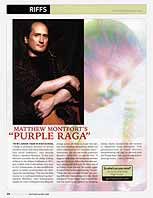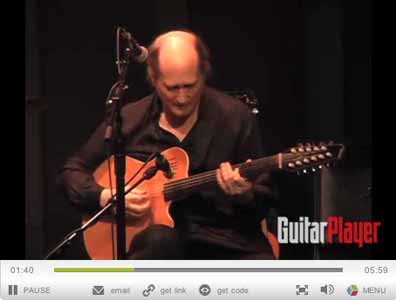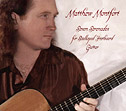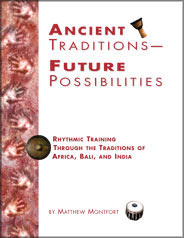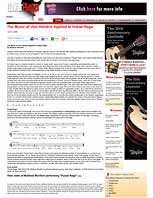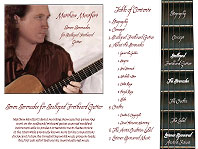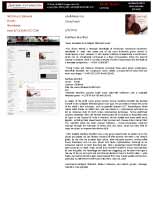
Issue 12. Fall 2009: Purple Raga – Indian Raga Through the Music of Jimi Hendrix
Welcome to the World Rhythms News, an infrequent newsletter dedicated to world music education. This issue highlights a GuitarPlayer.Com lesson from Matthew Montfort teaching Indian raga through the music of Jimi Hendrix and offers details about the World Music Workshop scheduled for New Year’s Day Weekend 2010 at Esalen. To subscribe, use the form below. Follow instructions thereafter, and make sure to check “World Music Education” in the “Interests” section of the sign up process.
In this issue:
Indian Raga Through the Music of Jimi Hendrix
In Guitar Player Magazine: Matthew Montfort Explains Jimi Hendrix Raga
MatthewMontfortGuitarPlayerMag.pdf (1.4 MB). This five page story from the December 2009 collectible commemorative Les Paul issue of Guitar Player Magazine includes a full page feature with a photo of Matthew Montfort superimposed over psychedelic artwork portraying Jimi Hendrix, an interview with Matthew Montfort about the scalloped fretboard guitar, Indian raga, and their relationship to the music of Jimi Hendrix, a video hosted by GuitarPlayer.Com of Matthew Montfort performing his ‘Purple Raga’ composition live at Ancient Future’s 30th Anniversary Concert, and a lesson on GuitarPlayer.Com created by Matthew Montfort entitled “The Music of Jimi Hendrix Applied to Indian Raga,” which explains the musical concepts behind the ‘Purple Raga’ track on ‘Seven Serenades for Scalloped Fretboard Guitar.’
Purple Raga
Live version of ‘Purple Raga’ from Matthew Montfort’s debut recording, Seven Serenades for Scalloped Fretboard Guitar
The Music of Jimi Hendrix Applied to Indian Raga
By Matthew Montfort (from GuitarPlayer.Com)
I began to think about the intersection between raga the music of Jimi Hendrix after seeing a photograph of Jimi in the front row of an Indian music concert, his mouth agape in awe of what he was experiencing.
One day a student of mine was having difficulty improvising over the chord changes in “Purple Haze,” and I had the idea that the techniques learned by studying Indian music would help my student to improvise more effectively.
An Indian raga is a melodic recipe for a mood: a “super scale” using a set of notes in ascending and descending order, a hierarchy of note importance, and a key phrase that shows the heart of the movement of the raga. I was inspired to create a modern raga based on the guitar solo in “Purple Haze.” Before I explain how to use this raga to create your own music that is tonally related to Hendrix’s solo, some explanation of the Indian system of music is necessary.
North Indian raga uses a system of solfeggio (i.e “do, re, mi, fa, so, la, ti, do”) known as sargam with seven note names per octave, starting with Sa (the tonic and main drone note) followed by Re (2), Ga (3), ma (4), Pa (5), Dha (6) and Ni (7). Indian music does not utilize the concept of perfect pitch where absolute note values are recognized. Sa can be set to any note, and is normally set to the most convenient place for the instrumentalist or vocalist. Just as in Western music, there are 12 main tones per octave, but there are also microtonal ornaments similar to the use of quarter tones in the blues. Indian raga uses a non-tempered tuning system where Sa and Pa are tuned a perfect just fifth apart. The other notes are close to the Western just tuning system, but the tuning of individual notes can vary from raga to raga. The word komal refers to the minor or flat version of a note, shuddh refers the natural or major version, and tivra refers to sharp or augmented version. Sa (1) and Pa (5) cannot be modified. Re (2), Ga (3) Dha (6) and Ni (7) can be either shuddh Re (M2), Ga (M3) Dha (M6) or Ni (M7), which correspond to the Western major intervals, or komal re (m2), ga (m3) dha (m6) or ni (m7), which correspond to the Western minor intervals. The note ma (4) can be either shuddh ma (P4), the natural perfect 4th, or tivra Ma (#4), which corresponds to the Western augmented fourth. In a common North Indian notation system, capital letter abbreviations are used for the version of the note that is highest in pitch and lower case letters for the note version lowest in pitch. For example, using this notation system, this is how a Western chromatic scale would be written:
. S r R g G m M P d D n N S
Purple Raga Phrases
To improvise within Purple Raga, one should first practice the ascending and descending scales. Notice that the patterns zig zag: they don’t simply go straight up and down a scale. This allows a raga to prescribe more than simply a mode and to include melodic instructions within the rule set. The heart phrase exemplifies an important melodic pattern for the raga. Try playing sections of the heart phrase in various octaves to emphasize the “purple” part of the raga.
While one could play “Purple Haze” using these melodic instructions, an unlimited number of improvisations in a similar tonal mood are also possible. On my Seven Serenades for Scalloped Fretboard Guitar release, rather than playing “Purple Haze,” I instead improvised a contemporary interpretation of the North Indian musical form known as alap (a rubato exploration of melody without rhythmic accompaniment). Each raga has a patron god or goddess, which in this case has to be the god of rock guitar. So I serenaded to the spirit of Hendrix while improvising within the raga rules I created inspired by the guitar solo in “Purple Haze.” Underneath, the didjeridu drones a chord in overtones: a D7#9, also known as the “Jimi Hendrix chord.”
Listen to Purple Raga
 (>audio)
(>audio)
“Purple Raga” (Montfort) 5:59. Matthew Montfort (scalloped fretboard guitar), Alan Tower (didjeridu). © 2008 Ancient Future Music (BMI). All rights reserved. From Seven Serenades for Scalloped Fretboard Guitar by Matthew Montfort. (AF 2008). $17.98: Buy 1 Now. (Checkout Option Sale!: 3 CDs for $30).
About Matthew Montfort
Matthew Montfort holds a B.A. in World Music and Composition and an M.A. in Arts and Media Technology from Antioch University. He is the leader of the world fusion music ensemble Ancient Future. A pioneer of the scalloped fretboard guitar (an instrument combining qualities of the South Indian vina and the steel string guitar), Montfort spent three months in intensive study with vina master K.S. Subramanian in order to fully apply the South Indian gamaka (note-bending) techniques to the guitar. His debut solo CD, ‘Seven Serenades for Scalloped Fretboard Guitar’ was released in 2009 to rave reviews on Ancient-Future.Com Records with national distribution through ADA/Ryko/WEA. He has performed concerts world wide, including at the Festival Internacional de la Guitarra on the golden coast of Spain near Barcelona.
Rhythm Training Material
Book
Book/Enhanced Audio CD Set with MIDI Soundfiles:$52.95 (SALE! Normally $69.95): Buy 1 Now.
Quotes
“You’ve heard Afro-Pop, sitar, gamelan and world music for years. But do you know what they are and how they work? Better yet, would you like to play those twisted cross-rhythms and melodies? In Ancient Traditions–Future Possibilities, Matthew Montfort, a founding member of the world music band Ancient Future, has put together the book for people who want to dig into world music with both hands. The first section of the book covers traditional music of West Africa, Bali and India with theories and exercises. Wherever possible, Montfort has provided beat counts alongside the standard musical notation so even if you can’t read music, you can still learn the rhythms.The last section of the book mixes patterns from different cultures, demonstrating the powerful music these simple exercises can generate.” – Richard Kadrey, SAN FRANCISCO CHRONICLE.
“A hands-on exploration of Balinese, African, and Indian rhythms that should appeal to all musicians. One needn’t play percussion instruments, or any instruments at all, for that matter, to use and benefit from the book.” – DRUMS AND DRUMMING
“Very highly recommended for any instrumentalists hoping to expand their rhythmic horizons. If you’ve never investigated the beautiful clash of African polyrhythm, the incredible interlocking textures of Balinese music, or the complex metric structure of Indian classical music, check out Ancient Traditions–it will blow your mind and deepen your groove.” – GUITAR PLAYER MAGAZINE
“If you’re tired of programming your drum machine with the same old 4/4 back-beat, or you want to sharpen your rhythmic chops, this book is highly recommended.” – ELECTRONIC MUSICIAN
Melodic Training Material
Now on GuitarPlayer.Com: “The Music of Jimi Hendrix Applied to Indian Raga” by Matthew Montfort
Free Educational Liner Notes
Digital Liner Notes (1.7 MB)
18 pages of educational liner notes including sheet music and in depth explanations of melodic concepts utilized in world music.
Quotes
Download the 65 page report of media placements for ‘Seven Serenades for Scalloped Fretboard Guitar.’ Complete reviews, photos, and links to online reviews. MediaMatthewMontfort.pdf (3.9 MB).
“A true guitar wizard.” – Jello Biafra, ALTERNATIVE TENTACLES RECORDS
“This album reveals a thorough knowledge of Hindustani microtonal ornaments, transferred in ways that create one of the most distinctive guitar sounds in contemporary music. However, it also reveals a lifetime of exploration in world music, which can be immediately summoned in a flash of inspiration. When this level of mastery is reached, there is no need to rewrite. The first improvisation has the depth of a reworked composition.” – Teed Rockwell, INDIA CURRENTS, March 2009
“Matthew’s playing is always impeccable, filled with subtle emotion and even wanderlust. I don’t know of anyone who plays quite like Matthew. His mastery of the scalloped fretboard guitar seems unequaled. For a richly rewarding journey into the magic of acoustic world fusion music, look no farther than ‘Seven Serenades for Scalloped Fretboard Guitar.'” – Steve Ryals, FRESH TRACKS
“Leader of the world-music band Ancient Future since 1978, Matthew Montfort has adapted many string instrument styles – from sitar to zither – to his guitar. His special scalloped fretboard allows him to tweak the strings in unique ways, but his virtuosity is a lot more than technical.” – David Rubien, SAN FRANCISCO CHRONICLE
“It isn’t every day that acoustic guitarists make their instrument sound a lot like an Indian sitar, but that is exactly what Matthew Montfort accomplishes on the instrumental ‘Seven Serenades for Scalloped Fretboard Guitar.’ Through it all, Montfort demonstrates that even though he has considerable chops and technical prowess, he is much more interested in feeling and expression than technique. This 56-minute CD is an adventurous, consistently engaging demonstration of what Montfort can accomplish on the scalloped fretboard guitar.” – Alex Henderson, ALL MUSIC GUIDE
“Though he plays guitar, Montfort’s music isn’t merely guitar music; it’s a sonic environment that features a guitar. Strong Indian and Balinese influences permeate these seven exotic soundscapes. Beautifully recorded, this sumptuous music creates a unique wall of sound that you won’t soon forget.” – Steven Stone, VINTAGE GUITAR MAGAZINE
All compositions, recordings, video, and text in this article are ©, Patent 2009 Ancient Future Music. All rights reserved.

As leader of the world music group Ancient Future, Matthew Montfort has devoted himself to the scalloped fretboard guitar since 1978. He spent years of study with some of the world’s best musicians, such as gamelan director K.R.T. Wasitodipuro, North Indian sarod master Ali Akbar Khan, and vina master K.S. Subramanian, with whom he did an intensive study of South Indian note-bending techniques. He was interviewed in the December 2009 Les Paul issue of Guitar Player Magazine about the scalloped fretboard guitar and the application of the rules of Indian raga to the music of Jimi Hendrix as exemplified by ‘Purple Raga’ from his debut solo recording, “Seven Serenades for Scalloped Fretboard Guitar.”
He has performed concerts worldwide, from the Festival Internacional de la Guitarra on the golden coast of Spain to the Festival of India in Mumbai. He has worked with many world music legends, including tabla phenomenon Zakir Hussain and Chinese zither master Zhao Hui. Montfort wrote the book Ancient Traditions & Future Possibilities: Rhythmic Training Through the Traditions of Africa, Bali, and India, which has been used by many musicians to improve their rhythm skills.


